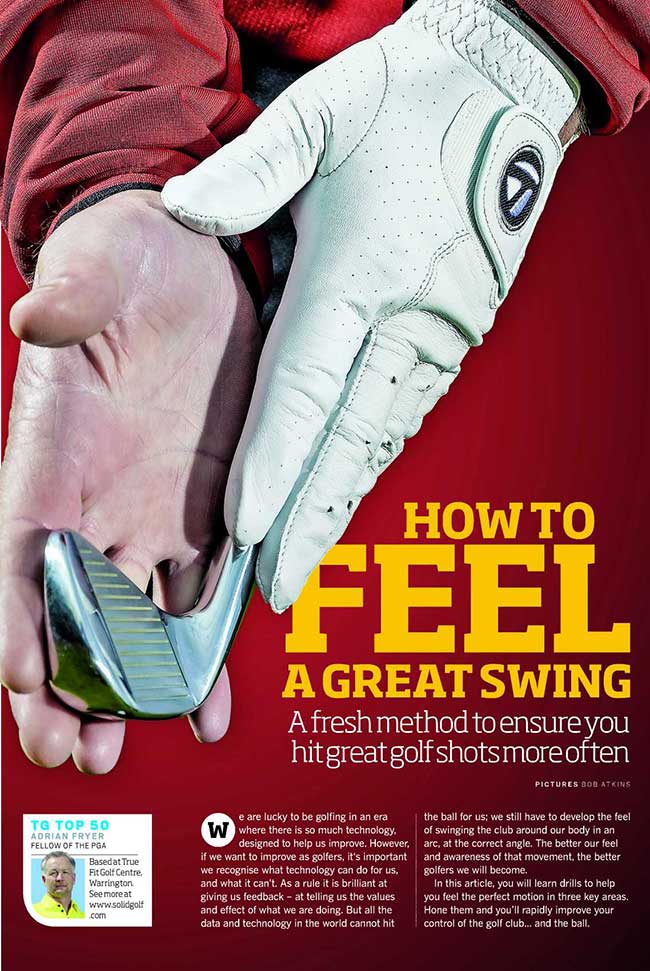So you’ve just watched golf on tv and seen the ladies and gent Tour Stars making apparently effortless simply swings and smashing the ball between 270 and 300+ yards. You head to the course and try to emulate their movements but for some reason for most golfers this doesn’t seem to yield the same results, often not even similar.
The same may apply when you’ve watched a useful tip on You Tube or even a magazine article, you intellectually grasp the concept but the only problem is your body doesn’t seem to be able to recreate the same shape, look and accuracy of the movement the Pro does.
There is an old saying amongst many coaches like myself ‘feel is not real’, so what does this mean? For any standard of golfer, Tour player included, sometimes what you feel you are doing, or where you may feel your limbs or the club are in space is actually nothing like where they really are. Through constant practice, maybe a touch of crossover from other neural pathways built with through other skills an Elite performer has developed better proprioception, better awareness of where the club and body are in space.
Question many amateurs often ask a professional during a lesson are,
“What does it feel like?’ ‘What should I be feeling with my hips, arms etc?”
Let’s never lose sight of the fact
Golf is about what the ball does!
However the ball responds to the quality of the information it receives from the club head through impact and we have the responsibility of moving the club efficiently with the sole aim of sending that ball on target. The set up and movements of your body should move the club in a fashion that encourages repetitive controlled shots of the appropriate power, shape and trajectory. Although not exhaustive my latest feature in this month’s Today’s Golfer Magazine (issue 345) goes some way to describing how the correct swing with the correct elements may feel. From the time golf began, all golfers on full shots have had to master turning their body and swinging their arms in harmony and in particular ‘corridors’ or shape. With the information in the feature plus the aid of your mobile phone, a mirror or enlisting the help of a PGA professional with feedback tools like video and even a launch monitor for ball data you can really start to see where your technique is and isn’t conforming. There has recently been many many studies on human learning and productive practice. Certain things are for sure, your practise swings are usually better than your real ones!
You may need to over exaggerate a feeling to see a minimal visual difference. You will need to produce a slow motion representation of your new movement before you can produce it accurately at high speeds. If you can combine a picture with a feeling your learning will be accelerated as your eyes allow you to monitor the degree and quality of your movements. Mirrors and video confirm via the images what you are now feeling through your senses. Feeling the correct motion can come from these images plus relating to analogies of similar movements and doing drills or using training aids to provide a feel of the action. The learning takes place when you recognise the new sensation ‘unsupported’ and begin to rehearse and cement it with the ball, then ultimately long term recreate some pressure to test it and produce when it matters.
In this feature I’ve aimed via drills and pictures to give you the student an opportunity to ‘feel’ what your body should be doing. This is interlinked with developing an awareness of what the club is doing, what angle is it moving on? What’s the club face doing? Synchronise, practise and refine these components like learning a dance or skimming a stone and soon you will be looking like the Pro’s you’ve studied. Furthermore if the ball is getting in the way of your new polished, balanced stylish correctly shaped swing then it will start to ‘feel’ efficient and achievable. You don’t need to be a golf pro to recognise someone with a stylish swing, with this feature I hope you can begin to see and feel a great swing for yourself, enjoy the practice.
For more details on Today’s Golfer Magazine and how you can read this article and more, you can visit their website here.

A great read Adrian. I wish I had more feel at the top of my swing. Looking forward to reading the article.